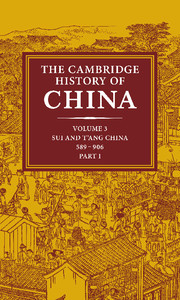Book contents
- Frontmatter
- 1 Introduction
- 2 The Sui dynasty (581–617)
- 3 The founding of the T'ang dynasty: Kao-tsu (reign 618–26)
- 4 T'ai-tsung (reign 626–49) the consolidator
- 5 Kao-tsung (reign 649–83) and the empress Wu: the inheritor and the usurper
- 6 The reigns of the empress Wu, Chung-tsung and Jui-tsung (684–712)
- 7 Hsüan-tsung (reign 712–56)
- 8 Court and province in mid- and late T'ang
- 9 Court politics in late T'ang times
- 10 The end of the T'ang
- Glossary Index
- References
8 - Court and province in mid- and late T'ang
Published online by Cambridge University Press: 28 March 2008
- Frontmatter
- 1 Introduction
- 2 The Sui dynasty (581–617)
- 3 The founding of the T'ang dynasty: Kao-tsu (reign 618–26)
- 4 T'ai-tsung (reign 626–49) the consolidator
- 5 Kao-tsung (reign 649–83) and the empress Wu: the inheritor and the usurper
- 6 The reigns of the empress Wu, Chung-tsung and Jui-tsung (684–712)
- 7 Hsüan-tsung (reign 712–56)
- 8 Court and province in mid- and late T'ang
- 9 Court politics in late T'ang times
- 10 The end of the T'ang
- Glossary Index
- References
Summary
The powerful decentralized provincial order which emerged in China after the middle of the eighth century was a direct result of the An Lu-shan rebellion of 755–63. After the founding itself, the rebellion is without doubt the most significant event in the history of the dynasty. It transformed a centralized, rich, stable and far-flung empire into a struggling, insecure and divided one. It has long been treated by historians as a turning-point in T'ang history; in recent decades it has even been treated as a major turning point in Chinese history as a whole. Yet, there is a striking disparity between the event and its consequences. Although such a major internal upheaval was bound to have grave and far-reaching effects, could what was essentially a military event have brought about the profound changes which differentiate the second half of the dynasty from the first so completely?
In reality, the changed situation of China after An Lu-shan's rising resulted not merely from the rebellion alone, but had its roots in developments long under way. As preceding chapters in this volume have shown, T'ang political institutions had undergone significant modifications since the beginning of the dynasty. These changes already anticipated the emergence of forms of government quite different in character from those of early T'ang. But it is imperative to distinguish these long-term changes from the specific origins of the rebellion itself. There was nothing inevitable about this event, even though when it came, it caused a tremendous disruption and acted as a powerful catalyst.
- Type
- Chapter
- Information
- The Cambridge History of China , pp. 464 - 560Publisher: Cambridge University PressPrint publication year: 1979
References
- 3
- Cited by



